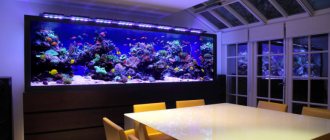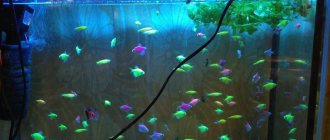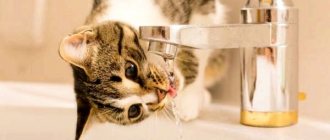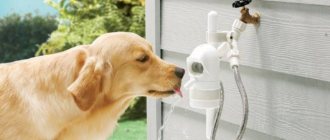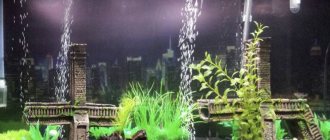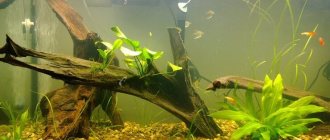Why do this?
The settling procedure is necessary in order to rid the water (completely or at least partially) of harmful impurities that can adversely affect the health and life of fish and other inhabitants of the aquarium.
Harmful substances can be divided into three groups: liquid, solid and gaseous. By settling, you can only get rid of the last two, since the liquid ones are already dissolved in water and will not disappear just from settling.
Solids should not be found in tap water, but this phenomenon is quite common - rust or lime can be scraped off from old pipes . And if the liquid is collected, for example, from a spring or well, then sand, small pebbles or other substances may come across. If you let the water sit, you can get rid of them very easily.
Gaseous impurities can also be easily removed. Only if small grains of sand in small quantities are practically harmless to fish, then chlorine and ammonia, which can be found in tap water, pose a much greater danger.
Chlorine is added to water to rid it of harmful bacteria. But for fish, such an additive is deadly - they can get burns or even die. Therefore, it is necessary to settle the water with the lid open - otherwise the gaseous substances will not evaporate.
Is it possible to put fish in unsettled water?
As stated earlier, chlorinated tap water without proper treatment is unsuitable for aquatic life. Chlorine can be removed in two ways:
- the first method is intensive aeration, i.e. saturating water with oxygen using an aquarium compressor;
- the second is the use of a special preparation - a conditioner, which removes not only chlorine, but also other chemicals and heavy metals dangerous to fish. In this case, you do not need to wait several days for the water to settle. The conditioner is sold at any pet store. You just need to read the instructions carefully before use.
If you are preparing an aquarium for the first time, it is advisable to use both methods.
Conclusion
As it turned out, preparing an aquarium for fish on your own is not so difficult. You just need to be patient and follow the simple recommendations given in this article.
Water for aquarium fish at home:
How long should the sediment last before introducing fish?
It all depends on what kind of water and what impurities in the composition will be used.
If the liquid comes from the tap?
If it is tap water, then you need to know what is added to it to get rid of bacteria - chlorine or chloramine. Of these two, chlorine is more expensive, and the duration of its bactericidal aftereffect is shorter.
If chlorine is added to the water, then it needs to be left for about a day, and if chloramine is added - at least a week . It is in 7 days that the substance will completely disappear from the water.
You can speed up the process by placing the container in a well-ventilated place. This will reduce the settling period to four days.
From the river
River or well water. Beginning aquarists often believe that the ideal water for an aquarium is river or well water. But in order to use it, you need to make sure that it has the appropriate level of hardness and PH, and that there are no toxic or poisonous impurities. Such analyzes can take a lot of time and effort.
But if the water is suitable for an aquarium in all respects, then you must first heat it to 70 degrees to kill most of the harmful bacteria, and then the water from the well must be settled for 24 hours, after which all solid particles will settle. It is enough to settle river water for 2-3 days. During this time, all the sand and clay particles will settle to the bottom and the liquid will become absolutely suitable for fish.
Rainy
Using rainwater is a rather unusual and rare method. Here, again, you need to make sure that such a liquid does not contain toxic substances. In large cities, it is better not to collect such water at all due to exhaust gases, smog, and waste from factories and industries. If the quality of the water turns out to be satisfactory, then it should be left for a week to remove any possible gaseous harmful substances.
Settling time can be reduced by using special reagents . They are called dechlorinators, and perform the function of binding chlorine and ammonia. The use of such reagents allows you to pour tap water into the aquarium within a couple of hours. Today their variety is great, and in any pet store you can find one that meets any requirements and price.
The duration of settling depends on the nature and amount of harmful impurities in the water.
How long to settle water for an aquarium
Aquarists call different periods for water settling: three hours, a week, 14 days. In reality, if there is visible sediment, the water is left to settle for up to half a day; this is no longer effective. The maximum effect can be achieved within a day.
Solid particles fall to the bottom after a few minutes. This process is observed visually. Gaseous substances begin to evaporate already at the moment of water intake. You can speed up the removal of chlorine by stirring. When it wears off, it will become clear that there is no characteristic odor. If the drinking water in the region is of high quality, without chlorine, from a plastic water supply, three hours is enough. During this time, the water will level out in temperature.
How long the water needs to settle also depends on the container. It is desirable that it be wide and voluminous. Then the process will go faster. When there is a lot of chlorine and other impurities, the process can be extended to two days, no more. There is no point in standing water any further. There is a danger that microorganisms that the fish do not need will begin to multiply. The aquarium has its own special microflora, which helps the life of its inhabitants.
How to do everything right?
The sequence of actions depends on what kind of water will be used for the aquarium.
- River or lake water (if it does not contain harmful impurities and is soft enough) must first be heated to 70 degrees, then cooled.
After which the water is poured into a container and covered with a thin layer of gauze. After a day, water can be poured into the aquarium. If this is the first time you use such water, it is better to try adding it in small portions, carefully observing the reaction of the fish. - Rainwater can only be collected in forest or rural areas, away from factories and large industries. You need to start collecting 20 minutes after the rain starts, as the first drops absorb dust particles from the air. After the liquid has been collected, cover the container with a thin layer of gauze and let it sit for 24 hours.
- Tap water must be drawn under high pressure. The container in which the water will settle should be wide and shallow - this will allow weathering to occur faster. The container must be open, otherwise the chlorine will not evaporate.
If water is not being added for the first time, then you can add it partially without changing all of it. Purified water should also be used for this.
How to prepare the water in the aquarium for adding fish
Settling the water before adding and launching fish and shrimp is a mandatory procedure. To achieve the desired result, it is important to do the following correctly:
You can stand water only in containers suitable for drinking (food containers or ordinary glass jars are suitable). To prevent air circulation from being disrupted, do not cover them with lids. It is better to use mesh fabric (gauze).
Settled water is safe for fish if it is done by topping up or partially replacing it. When setting up your home for the first time, you can start the fish 6-7 days after the flood. This is necessary so that a biological environment has time to form in the aquarium.
Is it necessary?
It is not necessary to settle the water, but it is necessary to purify it . If it is not possible to use modern methods (water conditioners, filters, special preparations), then settling is the easiest and safest way to make water clean.
What will happen to the fish if you add the wrong liquid?
If the water is not properly purified, the fish and other inhabitants of the aquarium will be exposed to harmful impurities. So, ammonia can cause fish to get burned and die. Due to the large amount of sand or clay particles, the gills of fish can become clogged, which can also lead to illness or death. Chlorine, which is added to tap water, burns the scales of fish, which certainly leads to death.
Both snails and plants in the aquarium suffer from harmful impurities. Therefore, the water must be prepared.
In what cases is the procedure not necessary?
You only need to defend tap water that comes through the central pipeline.
Other water does not need settling, for example:
- Bottled;
- Osmosis;
- Distillate;
- Spring;
- Melted.
There is no chlorine in it, so this procedure does not make sense.
But you can let any water stand for several hours so that the temperature is equal to room temperature and the fish are not stressed due to sudden temperature changes.
Alternatives
The most common method of water purification, which is actively used by aquarists, is the use of special conditioners. They can be purchased at any pet store.
To do this, take water into a container and add conditioner according to the instructions. After this, aeration is carried out for 15-20 minutes and the water is completely ready for use.
The advantages of this method are obvious - you don’t need to spend a lot of time and effort, all harmful substances are removed from the water, and you also don’t need to place basins or pots of water around the apartment for a week. But there are also disadvantages - settling can be done for free, while you have to pay for air conditioning . You also need to wait until the water temperature becomes suitable for the fish, that is, the basins will still be placed around the apartment, albeit for a shorter period.
Another method is to use special filters instead of settling. On the one hand, this device saves time, but on the other hand, on the contrary, you have to filter the water manually. The main disadvantage of this method is that many experts do not consider it completely safe and only advise adding filtered water (no more than 30% of the total volume), and not changing it completely.
Adviсe
- Don't change the water too suddenly. To avoid harm to aquatic inhabitants, all changes in the aquarium occur gradually.
- Stock up on tests in the spring. Depending on the result, decide whether the water is suitable for fish; it should contain all the necessary elements. If they are not available, then use special additives.
- Renew the water not completely: 20–25%.
- Too frequent changes are a source of stress for fish. Change the water weekly. Frequent replacements are appropriate when breeding fish or when disease appears in the aquarium.
- To properly maintain an aquarium, water changes alone are not enough. Periodically clean the soil with a siphon, wash the equipment and decorations, and clean the walls of the aquarium from plaque.
- In pet stores, water is tested to obtain a detailed report on the chemical and bacteriological composition.
Of course, inexperienced aquarists have encountered cases where fish survived when immersed in unprepared liquid. Guppies or catfish can withstand sudden changes in parameters and live in low-quality water. Such oversights do not go unnoticed even for unassuming pets; this affects the appearance and life expectancy of the fish.
Previous AquariumBeginner aquarists about aquarium care Next
AquariumChoose or make a stand for an aquarium with your own hands
Video on the topic
You can learn about the nuances of settling water by watching the video below:
Sedimentation is a basic classic method of keeping water safe for aquarium inhabitants . Many people have been using this method for many years and do not see any disadvantages in it. Everyone can choose any method convenient for themselves, the main thing is that the liquid is clean and does not cause harm to the inhabitants of the aquarium.
- Related Posts
- Basic water parameters in an aquarium
- What is CO2 for an aquarium?
- Why does the life of fish depend on the preparation of water in an aquarium and how to do everything correctly?
How long should the procedure take at home and how to correctly determine readiness?
With a normal area of contact with air, chlorine disappears 100% in three days , chloramine in a few hours (up to a day).
But for peace of mind, you can use a special aquarium chlorine test - Cl2 Test. These can be drop tests or strip tests.
Experienced aquarists recommend purchasing this test , first of all, in order to check tap water. This will let you know what you have to deal with.
Perhaps there is no chlorine in the water supply, then settling is an unnecessary “dance with tambourines.”
Note! The test will determine the need for settling and will also show whether the settled water is ready for use in the aquarium.
Solid impurities
The presence of solid impurities in water does not meet established sanitary standards and is considered detrimental to aquarium fish. Tap water contains rust and other solid particles, which can be eliminated through proper settling. Unfortunately, it will not be possible to get rid of lime deposits, which indicate increased hardness levels.
The exception is modern water supply systems with plastic pipes that guarantee the absence of solid particles and suspended matter in the water.
Impurities in spring and well water. Some aquarists believe that water obtained not from a water supply, but obtained from a well, springs, or natural reservoirs cannot contain solid impurities. However, such water contains fine sand and rot, creating turbidity. Such an aquatic environment is extremely dangerous for the inhabitants of an artificial reservoir.
Cleaning from impurities. In order to effectively clean aquarium water from solid particles, you must:
- Fill the container with the required volume of water and leave it to settle for several hours.
- If solid particles visible to the naked eye are detected, let the water steep for another half a day.
- For preventive purposes, carry out special tests at least once a year to monitor the presence of solid particles in water and their quantitative indicators.
After solid particles settle to the bottom, it is pointless to let the water sit for more than 24 hours, since this will bring absolutely no result.
Water parameters
An aquarium is a real ecosystem. The water that was poured into it contains many different compounds, bacteria, etc. Even the collected water is not exclusively H₂O. It has its own characteristics. To ensure that fish and other pets do not get sick and feel comfortable, the aquarist needs to create optimal water parameters.
In general, when dealing with an aquarium, an underwater flora and fauna lover is faced with various characteristics. For example, this is acidity (pH). This is the pH value of an acidic environment. The neutral value is 7 pH. It is the most universal and suitable for most plants and animals. If the acidity is less, this indicates high alkalinity of the water; if it is more, then, accordingly, it is considered acidic due to the high concentration of dissolved minerals.
It’s worth noting right away that pH is a very flexible parameter, since it can change and in general is influenced by a lot of factors. This includes aeration, temperature, presence of decor, soil, plants, nitrate level, hardness. This indicator exclusively affects the well-being of fish, since each species has its own preferences.
But in general, acidity is of secondary importance, since in the natural habitats of these animals it varies significantly depending on the season and other factors. Fish easily adapt to pH. But, of course, it is better to control it. This can be done using litmus paper or special tests that are sold in every modern pet store.
The second most important parameter is hardness (dH). It depends on whether the aquarist can keep certain plants or fish. Hardness is a combination of a number of compounds in water such as calcium, magnesium, carbonates, and biocarbonates. It has a huge impact on the aquarium:
- Calcium and magnesium contained in water are necessary for the formation of the skeleton in fish;
- These same substances make the shells of snails, shrimp and crabs harder, which is vital for these animals;
- Well, of course, how quickly certain plants will grow depends on this indicator.
The normal dH is 5-25 degrees. Hardness is measured using standard tests or laundry soap.
If desired, dH can also be changed. If it needs to be raised, then shells of crustaceans or mollusks are thrown into the aquarium, as well as chalk, coral chips or limestone. To reduce it, you can add distiller or use melt water when making changes. You can also add plants such as elodea or hornwort to the aquarium.
First fill
Having decided what kind of water can be poured into the aquarium, you should know the rules for first pouring liquid into the tank:
- The aquarium is washed with plain water, the glass is wiped using soft sponges or rags.
- Place pre-treated soil on the bottom.
- Tap water is added to the tank and left to settle. Over time, the water will become cloudy due to bacterial growth.
- When the aqueous medium becomes transparent again, check the parameters of the liquid. If the indicators are normal, vegetation is planted and fish are stocked.

